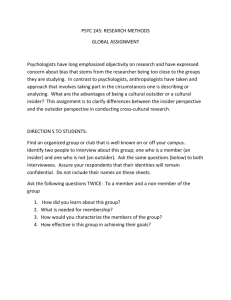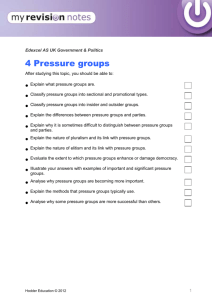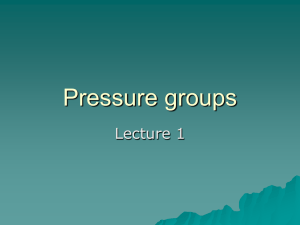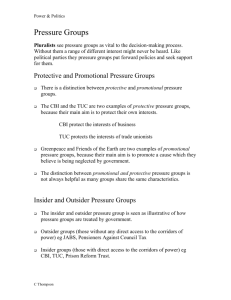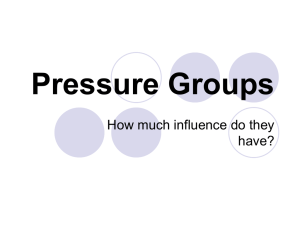Pressure Groups
advertisement
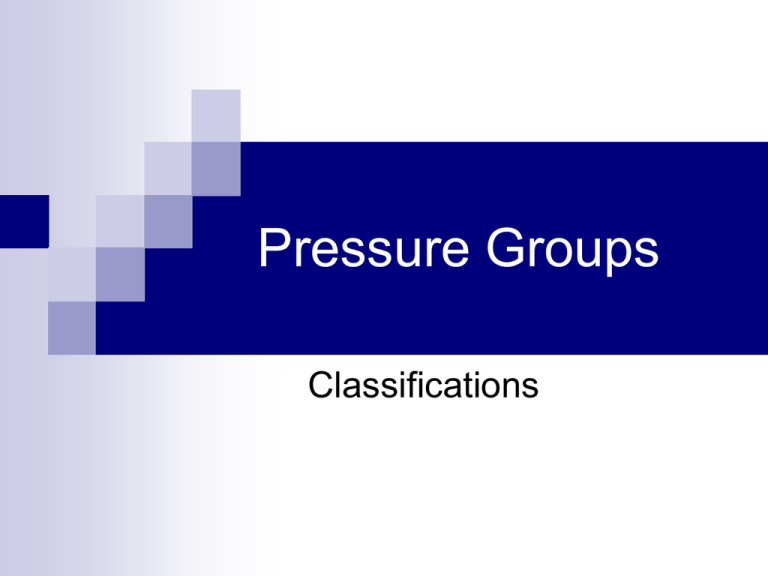
Pressure Groups Classifications Classifying Groups Stewart (1958) was one of the earliest theorists to attempt to classify or identify differing types of PG’s. He produced a division between ‘sectional’ and ‘cause’ groups. What are sectional groups? Sectional groups seek to represent the common interests of a particular section of society. As a result, members of sectional groups are directly and personally concerned with the outcome of the campaign fought by the group because they usually stand to gain professionally and/or economically. Because sectional groups are solely concerned with a particular section of society, membership is usually restricted. They tend to aim to get as many eligible members to join the group as possible. Give examples? It would be fair to say that individual selfinterest is the main motive for much of the activity of sectional groups. They are sometimes called ‘economic’ groups. They can also be categorised into ‘professional associations’. Give examples What are cause groups? Primarily exist to promote an idea not directly related to the personal interests of its members. They pursue a particular set of objectives (a cause), the achievement of which is not necessarily of direct professional or economic benefit to the members of the group. Examples Shelter – whose cause is homelessness CND – whose cause is nuclear disarmament The Society for the Protection of the Unborn Child – whose cause is the prevention of abortions The main point about cause groups and their membership is that they might potentially be supported by everybody, regardless of their profession or economic position. Therefore membership is not usually restricted. Cause groups are sometimes termed ‘promotional’ or ‘attitude’ groups. In the USA, cause groups are dubbed ‘public interest groups’, to emphasise that they promote collective, rather than selective benefits. Cause groups can also be subdivided according to the aims they pursue: Sectional cause groups Attitude cause groups What is the difference? Sectional cause groups: defend or promote the interests of specific social groups, e.g. Age Concern, Shelter, the Child Poverty Action Group, local voluntary associations. Attitude cause groups: share common beliefs and objectives on a particular issue and seek change in the interests of society as a whole e.g. the Electoral Reform society A point worth adding in relation to pressure groups classification is that many PG’s straddle the sectional/cause divide. By this, they represent both their members interests and are concerned with ideals of broader causes. E.G. TU’s often address the issue of social justice as well as matters such as wages, conditions and job security Insider and Outsider Groups As well as their differing forms, PG’s can be classified on the basis of their relationship to government. Some authors therein classify them in terms of ‘status’. The distinction is between ‘insider’ and outsider’. Insider Groups Enjoy privileged and usually institutionalised access to government through routine consultation and representation on government bodies. Such groups either tend to represent key economic interests or to possess specialist knowledge and information relevant to the government in the process of policy formulation. For example insider groups might be included in regular meetings with ministers or civil servants and they might be included on lists for circulation of new government proposals. Insider groups tend to be very powerful and long-term. It is more common for sectional rather than cause groups to be insiders, although this is not always the case. Generally they abide by the ‘rules of the game’. Insider groups can be further divided into two categories: The first is institutions within the state apparatus (e.g. Church of England or the police force). The second category is external groups. Whilst institutions within the state apparatus are consulted in the discussion process of governmental, the same cannot be true of external groups with insider status Instead they are independent organisations such as TU’s, charities or PG’s, which are called upon by the government to provide expertise when it is needed. The type of group selected varies according to the government’s ideological orientation and other factors such as public opinion So, the type of external groups given insider status varies from government to government. Grant (1990) on the other hand defined three types of insider group ‘Prisoner groups’: dependent upon government support, e.g. third world charities financed mainly by government ‘Low-profile’: e.g. the Chamber of Shipping, which works closely with the ministry of defence ‘High-profile’: e.g. the CBI used to be a discreet behind-the-scenes group, but then chose to court the media and acquire a higher profile What does an insider group need to gain ‘access’? Authority Information The compatibility of a group’s objectives with those of government Compatibility of group objectives with public sympathies Reliable track record Possession of powerful sanctions What are Outsider Groups? In general, outsider groups have none of the advantages of insider groups. They cannot expect to be consulted during the policy-making process. Nor can they expect to gain access to ministers and civil servants. Rather they have to work outside the governmental decision-making process and, therefore, have fewer opportunities to determine the direction of policy. Lacking formal access to government, these groups are forced to ‘go public’ in the hope of exercising indirect influence on the policy process via media and public campaigns. Grant (1985) identified three types of outsider group. Outsider groups hoping for a change in political climate often work closely with the opposition in Parliament and, generally, their strategy is to abide by the ‘rules of the game’ – ‘potential insiders’ Alternatively groups seeking insider status may be new groups with little experience, resources and expertise. Decision makers might support their aims, but do not consult them because they are thought to have little to offer. There is also a category of outsider group that does not aim for insider status because they are ideologically opposed to the political system – ‘ideological outsiders’ By definition, such groups have no interest in gaining access to governmental decision makers. Grant illustrates his typology with the example of animal welfare groups Range from respectable ‘insider’ RSPCA to the ‘ideological outsider’ Animal Liberation groups, using threats and violence to pursue their ends Grant’s distinction between insider and outsider groups has been criticised by Whitely and Winyard because it confuses: “the two separate dimensions of strategy and status” For example some groups can ‘enjoy close contacts with Whitehall yet ate the same time make considerable use of the media and public strategies of protest; They are insiders in terms of ‘status’, but outsiders in terms of ‘strategy’ Summary PG’s seek to influence policy and not control it. ‘Insider’ groups which win acceptance by government have a privileged position. Compared to ‘outsider’ groups on the periphery, which tend to use high profile techniques which serve to disguise their lack of real influence.

